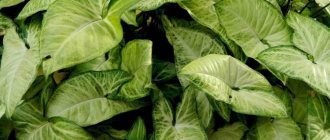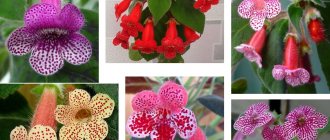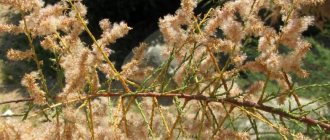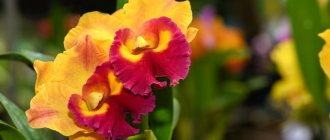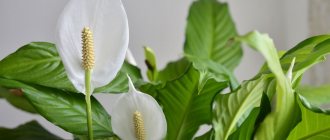Types and varieties of indoor syngonium: photos, names, descriptions of varietal varieties of flowers
In total, there are 35 species in the genus Syngonium. A complete list of syngonium species with Latin names is contained in the database of the Royal Botanic Gardens, Kew. Among them are Syngonium angustatum, Syngonium steyermarkii, Syngonium vellozianum, Syngonium triphyllum, Syngonium chiapense and others.
The most famous is the auricular syngonium ( Syngonium auritum ) - a vine with long clinging shoots, easily forms roots in the internodes, the leaves are glossy and green, young ones are almost arrow-shaped, old ones have a thrice-dissected plate and two ear-shaped small segments at the base. The length of its petioles is three to four tens of centimeters.
Wendland syngonium (Syngonium wendlandii) is considered rarer . A liana with leaves that are velvety to the touch (up to 19 cm in length and up to 8 cm in width), arrow-shaped, with a “tip” divided into three. It grows slowly, the size of the petioles reaches 20-30 cm. The plant's homeland is Costa Rica.
Legleaf (Syngonium podophyllum ) is the third of the syngonium species grown as indoor flowers, the most popular among gardeners. Native to Central America, where its fruits are eaten by the local population, in nature it is an intensively branching vine with flexible and thin shoots covered with large petiolate leaves. The petioles are long, up to 60 cm, the stems are covered with a waxy coating.
There are also variegated varieties of Syngonium podophyllum on sale, which are difficult to identify because they are hybrids. Varietal syngoniums are valued for their exotic coloring. They have somewhat poetic names associated with their external differences. Some varieties of syngonium are described below.
Pixie - plants of this variety are compact, with small green leaves and white spots located along the veins.
Bob Allusion - leaves are round, leathery, olive green in color when young, with noticeable pink veining.
Neon Robusta is a lush bush with bright pink leaves.
Regina Red - Known for its arrow-shaped, bicolor leaves, pink on top and green on the underside. The brightness of their color is directly related to the intensity of lighting.
Silver Moon - leaves are round, emerald in color, in the center there is a milky white spot with jagged edges.
Gold Allusion is a light golden vine with medium-sized leaves with bright pink veins.
Cream Allusion - bushes at the base, leaf color varies from silver to cream, veins are colored pink of varying intensities.
Mango Allusion – soft green foliage with pink centers.
White Butterfly is a variety with elongated, spear-shaped leaves. Their color can be green, milky, yellow, creamy pink. The leaf is covered with a web of light veins.
Panda - many yellow spots on a dark green leaf blade.
Arrow - distinguished by a variegated pattern around the veins, large shoots.
Salad - light green leaves with darker edges.
Silver Pearl - leaves are milky white above, light green below.
Angel baby, Fairy wings are dwarf representatives.
The photo shows decorative varieties of syngonium:
Syngonium has several distribution areas, but each species has an exotic homeland: South America (grows in French Guiana, Guyana, Suriname, Venezuela, Bolivia, Colombia, Ecuador, Peru, Brazil) or Central America (16 species are found in Costa Rica and Panama plants); In addition, some species grow in Mexico and the West Indies (Cuba, Jamaica, Haiti).
The names and differences between the types of syngonium are shown in the photo:
Reasons why Syngonium leaves dry out
As already mentioned, several types of syngonium and their hybrids are popular among indoor plant lovers. It does not bloom or bear fruit (the fruits of a wild plant are very fragrant and edible), but it fits almost any interior and is not too difficult to care for; growing quickly.
In addition, it is interesting to observe how the appearance of the flower changes as it grows: a young syngonium has completely different leaves from an adult. In a young plant they are arrow-shaped and not cut. Old specimens are distinguished by incised or even separated leaves.
The photo shows an indoor syngonium:
To understand how to properly care for syngonium at home, you need to remember where the flower grows in nature and provide it with a similar environment. Originating from the hot countries of Central and South America or the islands of the Caribbean archipelago, being a domestic flower, syngonium has certain temperature requirements: warmth, not lower than 15 ° C, warm soil - necessary conditions for the health of the plant.
But, despite this, it should not be provided with an excessively hot location: light or semi-shaded, without sun. Too bright sun is the first reason why syngonium leaves begin to dry out.
In summer, it is enough to place the perennial in partial shade, in winter - to provide a sufficient amount of diffused light. It can be adjusted using phytolamps.
The houseplant shown in the photo is a healthy syngonium, receiving optimal lighting, it has shiny, glossy leaves:
Tropical origin also dictates what air humidity should be for successful flower growth: high, it is necessary to spray the syngonium daily so that spots on the leaves or tarnishing do not appear. You can increase the humidity by placing a container filled with water next to the pot. The same requirements apply to watering: with softened water, do not allow the substrate to dry out.
The water must be filtered, settled and boiled, and at room temperature. It is important that it does not stagnate in the tray, otherwise the root system of the flower will suffer.
In summer, the frequency of watering and spraying is higher due to warming air and accelerated evaporation of moisture: in the hot season, the plant needs to be sprayed at least once a day, and in winter it is enough to wipe the surface of the leaves with a damp rag.
The frequency of watering is adjusted according to the rate of drying of the top layer of soil in the pot. In addition, in winter the flower should be kept away from heating sources: radiators and heaters.
Syngonium is undemanding to the substrate: a flower soil mixture with a small amount of peat is a sufficient condition for the normal development of the flower. The soil must be loose to allow both air and moisture to pass through; You can add a small amount of coconut fiber. Feeding is carried out regularly: every 2 weeks during the growth period, in the spring and summer.
With the onset of autumn, the frequency is reduced to once. The flower is suitable for organic or liquid mineral fertilizers that contain a small amount of calcium.
general description
Syngonium is a plant from the extensive Araceae family. In its appearance it is similar to many other large-leaved vines, however, none of them, perhaps, can compare with it in the variability of forms. An adult specimen can create the most bizarre silhouettes, which looks impressive and bewitching. In the limited space of apartments, the vine most often looks like a tangled mass of leaves, under which the petioles are practically not visible.
In the wild, the length of the lantern-shaped shoots reaches 20 m and the width is 6 cm; at home, its dimensions are more modest - usually the trunk is no more than 1-2 cm thick and grows up to 2 m. In addition, the crown of the flower is often trimmed to give it more compact and neat shape. Knobby growths protrude along the entire length of the shoots, from which aerial roots are formed over time, helping the bush to climb supports and receive additional nutrition from the environment. In the absence of support, the stem droops and continues to wriggle on the surface or hang freely like an ampel. The leaves have a heart- or spear-shaped shape that changes over the years from sharp to more rounded. Their color is monochromatic or with variegated patches, from pale light green, almost white, to pink-red and emerald green.
The name syngonium is of Greek origin and is translated as “seed”.
Formation of syngonium when caring at home and how to pinch the crown (with video)
As shown in the photo, depending on the variety, the syngonium is held as an hanging plant or tied to a support:
The formation of syngonium at home depends on the method of planting and care. If a grower wants to grow a climbing flower, he will need support and a drainage layer in the substrate so that the roots have something to hold on to. For the first, a plastic or wooden tube fixed in a pot is suitable.
You can decorate it with moss, which grows well in high humidity conditions, or with fabric that retains moisture. As it develops, the stem will beautifully wrap around the proposed support. A hanging plant requires the stems to be able to hang freely, so you can plant several cuttings in a hanging pot.
There are also varieties of syngonium that are short-growing and compact, for example, Arrow or Brocant: it is better to plant them in spacious boxes or bowls.
Important! It grows better in spacious shallow pots than in deep ones.
Proper care of syngonium at home includes the formation of the crown. Firstly, it facilitates the growth of the plant, which tends to stretch out greatly and make the support heavier; secondly, this allows you to emphasize its decorative properties, giving the plant the desired shape.
Fast growth and high adaptive abilities allow you to see the results of the grower’s efforts and correct possible mistakes in the shortest possible time. In addition to using supports with transverse bars around which the vine will curl, there is a more popular way to form a syngonium - pinching.
The method for pinching syngonium is no different from the methods used for other plants - using a knife or sharply sharpened scissors, the apical buds and/or buds located at the ends of the side shoots are removed. It is considered optimal to pinch the sprouts over every sixth leaf.
Carefully! Contains substances that irritate the skin and mucous membranes. All manipulations that injure plants are performed with gloves.
The video shows in detail how to pinch syngonium correctly:
Syngonium pests
At home, Syngonium most often suffer from aphids, mealybugs and scale insects.
Aphid. It attacks young leaves, which curl, turn yellow and dry out.
To spot the pest in time, inspect the plants regularly. If you notice aphids, carry out 2 - 3 treatments with Fitoverm (5).
Mealybug. It can be calculated by deformed leaves that quickly dry out and fall off.
To combat the pest, 2–3 treatments with Fitoverm or Actellik are used (5).
Shield. This insect forms colonies in the form of brown spots with a waxy coating on the underside of the leaves. Its vital activity leads to drying out of the leaves and slower growth of the syngonium.
A small number of scale insects can be removed using a cotton pad soaked in vodka. Severe infestation will require 2 – 3 treatments with Actellik (5).
Transplantation of syngonium when caring at home, propagation by cuttings and shoots
How to determine the time for syngonium transplantation at home?
It should be remembered that replanting is carried out as necessary, that is, the plant has developed so much that it is cramped in the old pot. A sign of this is the appearance of visible roots in the drain hole. This does not apply to young (2-3 years) syngoniums, which need to be replanted every spring.
In the process, the drainage is filled in first, then a third of the soil, after which the plant with straightened roots is placed in a pot, the rest of the soil is added and lightly pressed down, and a good spill is made. Fertilizers are excluded for 14 days after transplantation.
With proper care, Syngonium can be propagated well at home. As a rule, this is done in spring or early summer. There are two ways in which propagation is carried out: by apical cuttings or by separating shoots. To propagate by cuttings of an adult syngonium, the top of the plant is cut off, leaving a few aerial roots, and rooted in soil or a container of water.
The soil should consist of peat and sand, taken in equal proportions, boiled, filtered water with the addition of activated carbon is used. Rooting is carried out at a temperature of 24-26°C.
When syngonium is propagated by shoots, separate one of the young side shoots, which has at least 2-3 eye buds. Rooting is done in the same way, after which the plants are planted one at a time or several at a time, depending on the size of the pot and the wishes of the grower.
Care
Pot
You don’t have to focus on the shape - syngonium can grow well in almost all containers. The only exception is, perhaps, the “bonsai bowl”, in which the depth significantly exceeds the width. Select a container in which the depth exceeds the width . Suitable material is clay or plastic. Do not take the container for “growing” - the root system will be uncomfortable in a large pot.
The signal that it is time to replant the flower will be the roots growing out through the drainage holes.
Priming
Any substrate is suitable, the main thing is that it should be light, loose and nutritious. Heavy soil, which turns into a slab after watering, is absolutely not suitable for syngonium. Acidity level – neutral or slightly acidic. You can buy a mixture for aroids in the store, or you can make it yourself by mixing sand, humus, peat and leaf soil in equal parts.
If the substrate turns out to be too heavy, add a handful of perlite or expanded clay to it; a couple of tablespoons of bone meal will not hurt. Finely crushed polystyrene foam, expanded clay or broken red brick are suitable for drainage.
Be sure to treat the finished mixture against pests : bake it in the oven, keep it in the freezer for a day, or steam it in a baking “sleeve” in a water bath.
Syngonium has two types of roots: aerial and underground. The latter supply the plant with nutrients from the soil and water, and the air ones (developing in the internodes) allow it to attach to any support.
Temperature
Comfortable temperature range: from +17 to +25 degrees. This applies to summer time. In winter, make sure that the indicator does not fall below +15. A short-term decrease in temperature is allowed (up to +9), but not with dwarf, more delicate varieties.
Syngonium does not tolerate drafts, so before ventilating, be sure to take the vine to another room.
Lighting
Syngonium will grow well on an eastern window, where there is plenty of light and no direct sunlight. And the plant is oh so afraid of the burning sun and quickly becomes covered with burns. In addition, excess light causes a houseplant to lose its bright colors and decorative appearance.
The western window is also suitable, but shading there on hot summer days will still have to be organized.
The northern window is too dark, but green-leaved syngoniums, which grow naturally in the undergrowth, will cope there too. The south window is absolutely not suitable.
Watering and humidity
Do not spare water for your syngonium - if it is patient with temperature changes, then the lack of moisture will quickly nullify all your growing efforts. Wait for the top layer of soil to dry and take hold of the watering can . Use spring or settled water for irrigation. The liquid will not come out of the tap: it contains too much chlorine, salts and other harmful compounds. The same applies to rainwater.
Roots left in water for a long time will turn sour, so wait 10-15 minutes after watering and drain the excess liquid from the pan.
On warm days, when the temperature is above 20 degrees, give the syngonium water treatments once a week: place the pot in the bathroom and water it from the shower. Do not forget to first wrap the pot itself with polyethylene so that water does not flood the soil and it does not turn into a swamp. After this, you will need to water when the soil is 2-3 fingers dry. If the vine is so large that it is physically difficult to take it to the bathroom, fill the soil once a month and leave for an hour and a half, and then drain the excess water from the pan. In winter, watering is reduced.
If you missed watering and the plant reacted to this with drooping leaves and lethargy, water the vine and cover it with a bag for a while. This will help quickly restore the original appearance.
Syngonium does not like dry air , so, firstly, be sure to buy a steam humidifier, and secondly, spray the plant with a spray bottle at least twice a day.
The crop should not be placed next to heating devices. When spraying varieties with pink leaves, whitish spots often remain on the latter, spoiling the overall picture. In such cases, you can spray not the flower itself, but the air around it.
Top dressing
Syngonium should be fed during the growing season - from spring to autumn. Varieties with variegated leaves - preparations with a large amount of microelements and a small amount of nitrogen (for example, "Uniflor" or any other fertilizer for ornamental foliage plants). Varieties with green leaves - preparations containing nitrogen.
Remember: the dose indicated on the package should be halved, since syngonium reacts negatively to excess nutrients, but is tolerant of deficiencies.
Transfer
Young plants should be replanted once a year, in the spring, adults - once every 2-3 years using the transshipment method. The first pot should not be more than 9 cm in diameter. You can plant several specimens in one container - in this case the green “cap” will turn out especially beautiful and lush.
- A couple of days before the procedure, moisten the soil in the pot so that the earthen ball does not crumble during transplantation.
- Remove the vine from the pot, inspect the roots, and remove rotten and damaged parts. If the plant is difficult to remove the first time, run the blade along the walls of the pot or tap the outside of the pot, and then turn the pot over, holding the plant with your index and middle fingers.
- If necessary, install a support in the pot and sprinkle it with expanded clay.
- Replant the vine in fresh soil, carefully straightening the roots. Fill the gaps between the walls of the pot and the crop with soil. Watering should not be done immediately, but several hours after transshipment. For the first day or two, keep the indoor plant in a slightly shaded place.
Crown formation
If you want to get a neat compact bush, pinch the growth point above the 6th leaf . This helps not only to increase the number of leaves, but also stimulates the forcing of shoots on the sides.
Provide a support for the vine - it will help the crop grow. You can attach moss or coconut fiber to the support: the syngonium will firmly cling to it with its roots. Moisten the moss with water every day so that the vine does not lack moisture.
Useful video about care
Syngonium - care, watering, maintenance temperature:
Why Syngonium leaves turn yellow and what to do to treat diseases
Regardless of how to care for a flower, the owner of a syngonium may encounter problems. Pests and diseases rarely affect the plant, but the grower should have an idea of the necessary actions if this happens. This section describes the most common syngonium diseases and their treatment.
What to do if the leaves of syngonium turn yellow?
First of all, you need to find out why syngonium leaves turn yellow: damage by parasites, due to too dry air or lack of light and nutrients. The first can be detected by visual examination of the plant; in the second case, yellowness appears from the tip and edges, the leaf itself becomes flabby and falls off over time; with the third reason, it initially grows small and does not fall off, even when completely yellowed.
The solution to the problem is optional: increasing air humidity, feeding outside the schedule, placing the flower pot in a more illuminated place, or using a phytolamp. These measures are usually enough to stop the syngonium leaves from turning yellow. In case of parasitic infestation, treatment is carried out in accordance with the type of pest; the affected sample must be isolated from the rest.


